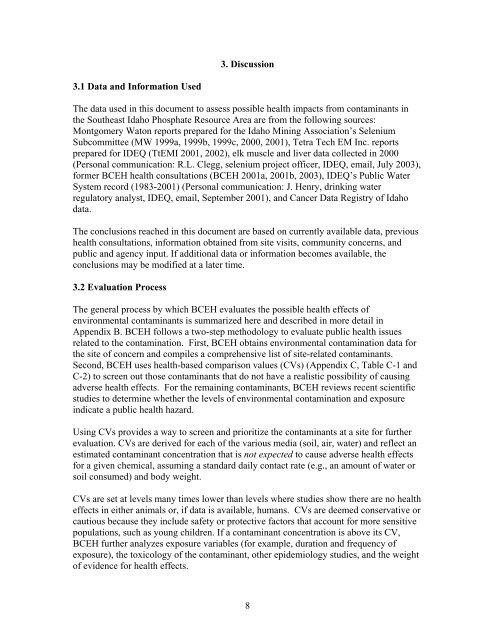Southeast Idaho Phosphate Mining Resource Area - Agency for ...
Southeast Idaho Phosphate Mining Resource Area - Agency for ...
Southeast Idaho Phosphate Mining Resource Area - Agency for ...
You also want an ePaper? Increase the reach of your titles
YUMPU automatically turns print PDFs into web optimized ePapers that Google loves.
3. Discussion<br />
3.1 Data and In<strong>for</strong>mation Used<br />
The data used in this document to assess possible health impacts from contaminants in<br />
the <strong>Southeast</strong> <strong>Idaho</strong> <strong>Phosphate</strong> <strong>Resource</strong> <strong>Area</strong> are from the following sources:<br />
Montgomery Waton reports prepared <strong>for</strong> the <strong>Idaho</strong> <strong>Mining</strong> Association’s Selenium<br />
Subcommittee (MW 1999a, 1999b, 1999c, 2000, 2001), Tetra Tech EM Inc. reports<br />
prepared <strong>for</strong> IDEQ (TtEMI 2001, 2002), elk muscle and liver data collected in 2000<br />
(Personal communication: R.L. Clegg, selenium project officer, IDEQ, email, July 2003),<br />
<strong>for</strong>mer BCEH health consultations (BCEH 2001a, 2001b, 2003), IDEQ’s Public Water<br />
System record (1983-2001) (Personal communication: J. Henry, drinking water<br />
regulatory analyst, IDEQ, email, September 2001), and Cancer Data Registry of <strong>Idaho</strong><br />
data.<br />
The conclusions reached in this document are based on currently available data, previous<br />
health consultations, in<strong>for</strong>mation obtained from site visits, community concerns, and<br />
public and agency input. If additional data or in<strong>for</strong>mation becomes available, the<br />
conclusions may be modified at a later time.<br />
3.2 Evaluation Process<br />
The general process by which BCEH evaluates the possible health effects of<br />
environmental contaminants is summarized here and described in more detail in<br />
Appendix B. BCEH follows a two-step methodology to evaluate public health issues<br />
related to the contamination. First, BCEH obtains environmental contamination data <strong>for</strong><br />
the site of concern and compiles a comprehensive list of site-related contaminants.<br />
Second, BCEH uses health-based comparison values (CVs) (Appendix C, Table C-1 and<br />
C-2) to screen out those contaminants that do not have a realistic possibility of causing<br />
adverse health effects. For the remaining contaminants, BCEH reviews recent scientific<br />
studies to determine whether the levels of environmental contamination and exposure<br />
indicate a public health hazard.<br />
Using CVs provides a way to screen and prioritize the contaminants at a site <strong>for</strong> further<br />
evaluation. CVs are derived <strong>for</strong> each of the various media (soil, air, water) and reflect an<br />
estimated contaminant concentration that is not expected to cause adverse health effects<br />
<strong>for</strong> a given chemical, assuming a standard daily contact rate (e.g., an amount of water or<br />
soil consumed) and body weight.<br />
CVs are set at levels many times lower than levels where studies show there are no health<br />
effects in either animals or, if data is available, humans. CVs are deemed conservative or<br />
cautious because they include safety or protective factors that account <strong>for</strong> more sensitive<br />
populations, such as young children. If a contaminant concentration is above its CV,<br />
BCEH further analyzes exposure variables (<strong>for</strong> example, duration and frequency of<br />
exposure), the toxicology of the contaminant, other epidemiology studies, and the weight<br />
of evidence <strong>for</strong> health effects.<br />
8
















